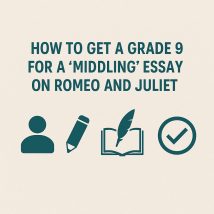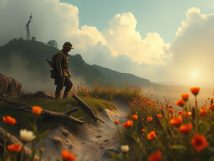year 11
-
🏅Model GCSE Essay on the Feud in Romeo and Juliet
If you’re teaching or studying Shakespeare’s ‘Romeo and Juliet’, you’ll know that essays about the family feud often hover around a Grade 4, 5 or 6—what examiners might call ‘middling’ or ‘competent’ responses. But with a few targeted improvements, these essays can be transformed into top-grade responses. I’ve updated one of my most popular blog posts to show exactly how to do this, paragraph by paragraph, with comments, grade 9 tips, and clear marking guidance for teachers and pupils alike. The key is to move beyond surface-level understanding and begin thinking like a literary analyst. That means really digging into Shakespeare’s language (AO2), showing a secure knowledge of the play and its themes (AO1), and crucially, thinking about why Shakespeare wrote what he did, and how his audience might have reacted (AO3). This is where the 5Ws strategy—Who, What, Where, When, Why—comes in. For example, instead of simply quoting the Prologue’s “ancient grudge” to describe the feud, a top-grade response will explore the word “ancient” in more depth. What does it suggest about tradition, time, and decay? What kind of audience would Shakespeare have been writing for, and why might he start with such a phrase? A Grade 9 student doesn’t just spot a quote—they zoom in on the language, explain the technique being used, and link it to Shakespeare’s bigger message about love, hate, and fate. I’ve used a visual symbol system in the new version of this post to make each part of the answer easier to teach and understand. A pencil icon stands for thoughtful analysis, a book and quill symbol represents literary and historical context, and a checkmark indicates where a pupil is showing Grade 8–9 thinking. I’ve also added a quiet but clear visual: a student figure at the centre of the learning, reminding us this is about developing real, mindful confidence—not just ticking boxes. This new breakdown works well for teachers modelling essays in class, for pupils revising independently, and for tutors looking for a clear teaching sequence. And if you’re looking for more structured support, I’d recommend my edition of the play, Romeo and Juliet: The Complete Play with Integrated Study Notes and Smart Translation—ideal for exploring language, structure and context in one place. For teachers, The Mindful English Teacher includes ideas for making literary analysis more inclusive, reflective, and emotionally aware. You can view the updated post and download the image resources now at francisgilbert.co.uk, or find the essay thread pinned to my socials. Let me know how you use it, and feel free to tag me with examples of Grade 9 insights from your own pupils!
-
My blogs, YouTube, Soundcloud and Twitter channels…
Together with a number of other eminent journalists and educationalists, I co-founded and help run the popular educational blog, Local Schools Network. I also blog for Mumsnet on Tales Behind The Classroom Door. My YouTube channel is Wonderfrancis. My Soundcloud Channel is Electric Schubert. I am @wonderfrancis on Twitter. Other blogs: A Streetcar Named Desire for […]
-
Good links for Wilfred Owen’s poetry
http://www.bbc.co.uk/history/worldwars/wwone/wilfred_owen_gallery.shtml http://www.bbc.co.uk/shropshire/content/articles/2005/03/16/wilfred_owen.shtml
-
My YouTube videos which explain Wilfred Owen’s Exposure and Spring Offensive
A blog post containing various videos I made some time ago explaining Wilfred Owen’s poem ‘Exposure’ to my pupils in secondary school, studying it for GCSE.
-
Louisa Young on her novel about the First World War.
Louisa Young is the author of the powerful novel, My Dear, I Wanted To Tell You, which is about a soldier who is horribly disfigured during the First World War. This is the video that the publishers made about the book: This is her explanation of how she came to write the book:
-
Dream of a lost friend by Carol Ann Duffy
Dream of a lost friend
-
A grade essay on A Passionate Shepherd and The Nymph’s Reply
Plan: Passionate shepherd… Nymph’s reply… Sims: -Direct language -Rhythm Diffs: -Imagery (remember caesura!) – Answer: In ‘The Passionate Shepherd’ a shepherd is pleading to a nymph (a beautiful woman) to go and live with him in the countryside. To persuade the nymph to go with him, Marlowe uses beautiful imagery of nature being harmonious […]
-
How does Hemingway develop a sense of anticipation and drama at the beginning of the Old Man and the Sea?
Hemingway’s opening is dramatic for a number of reasons. Read through the first two pages and/or listening to my podcast, and then list FOUR ways Hemingway develops a real sense of anticipation in the opening of the novel. Do you agree with these points? 1. Hemingway immediately tells us that there is a great deal […]
-
Composed on Westminster Bridge — an explanation for GCSE English Literature Podcast
Composed on Westminster Bridge; an audio explanation by Francis Gilbert “Composed upon Westminster Bridge, September 3, 1802” is a sonnet by William Wordsworth describing London, viewed from one of the bridges over the Thames, in the early morning. It was first published in 1807. Earth has not anything to show more fair: Dull would he be of […]
-
Town and Country quiz – revising the poems
Please add in annotations to the poems if/when you see fit as you are answering these questions London What does Blake notice in every face he meets? (weakness, woe or sorrow) TRUE OR FALSE: ‘Mind-forged manacles’ are chains created by minds which have been oppressed or brainwashed They are a special type of clothing people […]
-
Comparing Poems from Town and Country — mock exam questions
Comparing poem from Town and Country by FGI Comparing The Passionate Shepherd to His Love and The Nymph’s Reply to the Shepherd. Marlowe’s poem is very passionate. What imagery does the poet use to make the shepherd’s love seem so passionate? What are the delights that the shepherd is offering? In Ralegh’s poem, the […]
-
Comparing Lake Isle of Innisfree and A Dead Harvest In Kensington
How to write a fandaglistic hyperpolished poetry essay in timed conditions. Use this frame to help you! Explore the different ways in which the poets portray nature in ‘The Lake Isle of Innisfree’’ and ‘A Dead Harvest in Kensington’ Introduction: where you introduce the poems by explaining BRIEFLY what they are about. Remember you get […]
-
War Poetry – analysing and thinking about the poem, improving essays
Learning objective: to learn how to use quotation to develop your criticisms of the poems Key quotes: “German guns” Eyes were wild blindfolded English bullet in his heart Abject fear of death Deserter’s grave Panicked down the trench Mother’s grief The Deserter “To add more sympathy at the end, the poet goes on to say […]
-
Compare in which the poets movingly portray sympathy for the loss of life in wartime in these two poems: The Deserter and The Hero.
Format: Explain poem 1 Explain poem 2 Similarities In imagery and language Structure and themes Differences In imagery and language Structure and themes Conclusion to the question.
-
Re-writing autobiographical extracts, editing and improving them
Read these passages and answer the questions that follow: he looked like a turtle his little bald head with his oversized blazer, it looked like a home on his back! What is effective about this image? we seized every opportunity to get him back we didn’t care, we was going home after this and […]
-
How successfully does Hardy open Far From The Madding Crowd?
Learning Objectives To learn about the techniques Hardy uses to create a suspenseful opening to Far From The Madding Crowd To learn about the contexts of Hardy’s novel An important point Starter activity: put these elements of the opening in the correct order Gabriel Oak loses his sheep Oak is rescued from suffocation in his […]
-
Steps towards writing an excellent essay on the play
Lesson objective To learn how to use your notes to write an essay To collect your thoughts together quickly and write them down Starter activity – put these events in the right order Willy commits suicide Biff and Willy agree to set up the Loman brothers Willy remembers when there were trees in the yard […]
-
Coursework — writing a sequel to the play or writing an essay which analyses the use of suspense
English Death of a Salesman coursework To be completed in CONTROLLED CONDITIONS in class Either: Sequel plus commentary (COUNTS as ONE piece of coursework) Write a sequel to the play, set ONE year later, where Biff returns home to visit Happy and Linda. Set the scene in the house. DO NOT […]
-
Dramatising your life
Learning objectives: to learn how to dramatise elements of your life Learning outcomes To write in detail about an aspect of your life NOT covered in the autobiography in detail, but dramatised. The question will be: Write an entertaining account which explores in depth moments when you have been alone or lonely in your life. […]
-
The bully — reading an FGI extract and planning your answer
Read this passage, written by me and use it to help you plan your own autobiographical extract. Although I don’t know him at all, a kid, Andrew Mintern, in the year above senses my difference and decides to pick on me. One break-time there’s a massive surge after all the “spazzies” in the school […]


